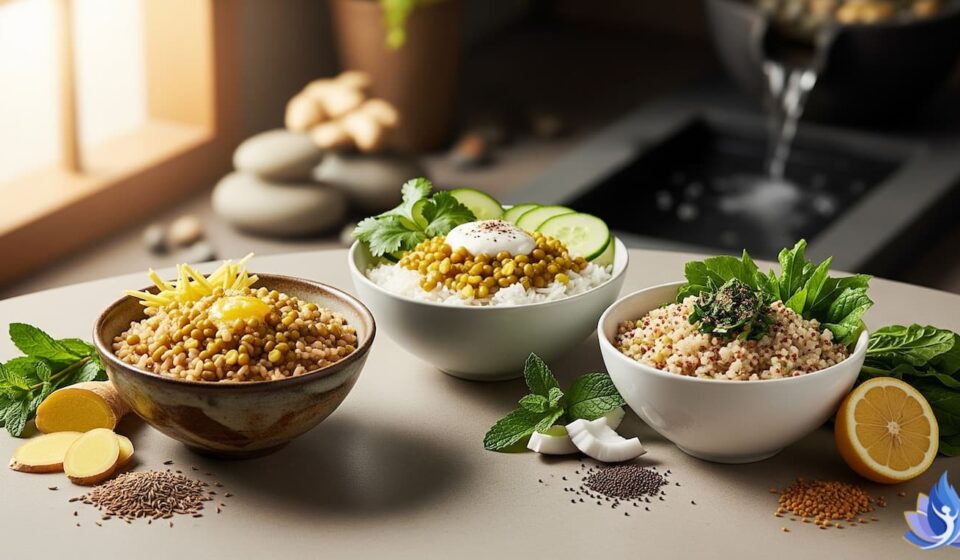
Your Ayurvedic Detox: A Gentle, Dosha-Specific Cleanse for Each Season
In the modern world, the word “detox” often conjures images of harsh fasts, restrictive juice cleanses, and extreme deprivation. But what if cleansing could be a gentle, nourishing, and deeply restorative process? Ayurveda, the ancient science of life, offers a profound approach to detoxification that is not about shocking the system, but about gently guiding it back to its natural state of balance.
Table Of Content
An Ayurvedic cleanse, at its core, is about removing Ama (metabolic toxins) and pacifying aggravated doshas (Vata, Pitta, and Kapha) that accumulate due to seasonal changes, stress, and improper diet. It’s a holistic reset for the body, mind, and spirit. While the most intensive form of this is Panchakarma, a supervised therapy, you can incorporate its gentle principles at home to feel lighter, clearer, and more vibrant.
The Three Phases of an Ayurvedic Cleanse
A traditional Ayurvedic cleanse follows a logical, three-part structure designed to safely prepare the body, eliminate toxins, and then restore strength.
- Purvakarma (Preparation Phase): This is the crucial first step. For several days before the main cleanse, you slowly prepare your body by eliminating heavy, processed foods, caffeine, and alcohol. The focus is on internal and external oleation (lubrication) to loosen deep-seated toxins.
- Pradhankarma (Main Cleansing Phase): This is the active detox period, which typically involves a mono-diet of kitchari and specific therapeutic procedures to expel the loosened toxins.
- Paschatkarma (Post-Cleanse Rejuvenation): After the cleanse, you slowly reintroduce other foods and focus on rejuvenation (Rasayana) to rebuild your strength and immunity.
The At-Home Cleanse: A Gentle, Dosha-Specific Approach
A gentle home cleanse focuses primarily on the preparation phase and a simplified main cleanse, making it safe and accessible for most healthy individuals. The key is to tailor the practices to your dominant dosha.
The Foundation: A Kitchari Mono-Diet For 3-7 days, the cornerstone of your cleanse will be a simple mono-diet of kitchari. This nourishing porridge of rice and mung dal is easy to digest, giving your digestive system a much-needed rest while providing complete nutrition. This allows your body to redirect its energy from digestion to deep cleansing and repair.
Daily Cleansing Rituals (for all doshas):
- Internal Oleation: Begin each morning of your cleanse by drinking warm ghee on an empty stomach. Ghee penetrates deep into the tissues, binding to fat-soluble toxins and drawing them into the GI tract for elimination.
- Abhyanga (Self-Massage): Before your morning shower, massage your entire body with warm, dosha-specific oil. This practice calms the nervous system and stimulates the lymphatic system to move toxins.
- Gentle Movement: Avoid strenuous exercise. Opt for gentle yoga, stretching, or walking in nature to support the cleansing process without depleting your energy.
- Hydration: Sip warm water and herbal teas throughout the day to help flush toxins from your system.
Customizing Your Cleanse for Your Dosha
For Vata Dominance (Air + Ether): Vata types need warmth, grounding, and nourishment during a cleanse.
- Herbal Support: Use warming, grounding herbs. Ginger tea is excellent. Ashwagandha can help calm an anxious Vata mind.
- Abhyanga Oil: Use warm sesame oil for its heavy and warming qualities.
- Lifestyle: Maintain a consistent routine, stay warm, and practice calming activities. Avoid fasting and stick to three warm kitchari meals a day.
For Pitta Dominance (Fire + Water): Pitta types need cooling, calming, and soothing therapies.
- Herbal Support: Use cooling herbs. A tea made of cumin, coriander, and fennel (CCF tea) is perfect. Amla is a great cooling and rejuvenating herb.
- Abhyanga Oil: Use cooling coconut oil.
- Lifestyle: Avoid overheating and intense activities. Spend time in nature, but out of the direct midday sun. Practice calming meditation.
For Kapha Dominance (Earth + Water): Kapha types benefit from stimulation, warmth, and lightness.
- Herbal Support: Use stimulating, warming herbs. Ginger and turmeric tea can help kindle a sluggish digestive fire. Trikatu is also beneficial.
- Abhyanga Oil: Use a lighter, warming oil like sunflower or mustard oil.
- Lifestyle: Emphasize movement. A brisk morning walk is essential. Dry brushing the skin before Abhyanga can help stimulate a sluggish lymphatic system.
“Natural forces within us are the true healers of disease.” — Hippocrates
This quote perfectly captures the essence of an Ayurvedic detox. The goal is not to force the body, but to create the right conditions for its own innate healing intelligence to flourish.
Conclusion: A Gentle Path to Renewal
An Ayurvedic detox is a profound act of self-care that honors your body’s unique needs. By aligning with the seasons and your specific dosha, you can gently cleanse accumulated toxins, reset your digestion, and restore your natural state of balance and vitality. It is a journey back to yourself, leaving you feeling lighter, clearer, and deeply rejuvenated.
A seasonal cleanse is a powerful way to reset your health. Have you ever tried an Ayurvedic detox? Share your experience or questions in the comments below, pass this article on to a friend, and follow us on social media for more wellness inspiration.










